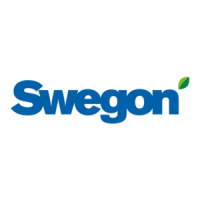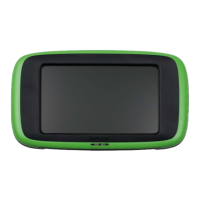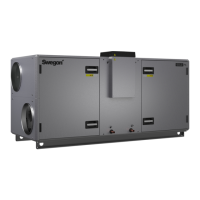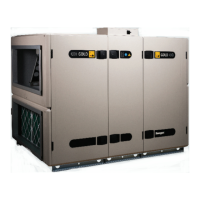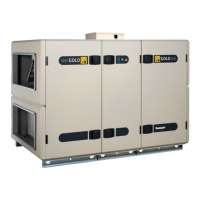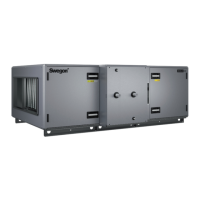Do you have a question about the Swegon GOLD RX 08 and is the answer not in the manual?
Outlines specific components of the GOLD RX unit with a rotary heat exchanger.
Details components of the GOLD PX unit featuring a plate heat exchanger.
Describes the components of the GOLD CX unit equipped with coil heat exchangers.
Explains the location and function of safety isolating switches on different GOLD unit sizes.
Warns about risks associated with rotating parts and operational hazards.
Details the role of safety guards and who is qualified to remove them.
Outlines the sequence for commissioning air handling units, including checks and setup.
Guides on adjusting duct systems and air devices for optimal airflow and comfort.
Explains how to adjust pressure balance in units with a rotary heat exchanger using adjustment plates.
Describes how to adjust pressure balance for correct leakage direction using adjustment plates.
Introduces the hand-held terminal, its components, and general information.
Provides an overview of the hand-held terminal's construction and features.
Explains the functions of each button on the hand-held terminal.
Illustrates the hierarchical structure of the unit's menu system.
Details how to start, stop, or switch between manual/automatic operation.
Covers basic temperature functions, allowing readings and settings at User Level.
Details settings for ERS Regulation, Supply Air Regulation, and Extract Air Regulation.
Explains how basic airflow and pressure functions are set and read.
Covers settings for low speed, high speed, max speed, and min/max speed for fans.
Describes how to preset and manage operating times and days for the unit.
Covers how to read active alarms and view the alarm history.
Provides an overview of the menu structure accessible at the Installation Level.
Covers basic temperature functions, allowing readings and settings at User Level.
Explains how to select and configure ERS, Supply Air, and Extract Air temperature regulation modes.
Details ERS Regulation 1 and 2 for controlling supply air temp. based on extract air temp.
Explains maintaining a constant supply air temperature, often requiring reheating coils.
Describes regulating extract air temperature for uniform premises temperature.
Allows compensating supply/extract air temperature setpoints based on outdoor conditions.
Utilizes lower night temperatures to cool buildings, reducing daytime cooling load.
Heats premises during normally stopped periods using an external room sensor.
Heats premises before the scheduled switch-in time, using air recirculation.
Allows changing supply/extract air temperature setpoints via an external 0-10 VDC signal.
Covers various methods for controlling airflow and pressure within the unit.
Allows individual selection of regulation type for supply and extract air fans.
Covers various operating modes for the unit.
Covers various heating functions, including heat exchanger operations.
Covers various cooling functions and regulation modes.
Explains various cooling regulation modes like CoolDX Economy, Comfort, and DXS.
Guides on replacing filters when the filter alarm is activated.
Explains how alarms are indicated and how to trace faults using menu information.
Details terminal connections for sizes 04-80, including Ethernet, EIA-232/Modem, and various functions.
Details the electrical specifications of the units.
